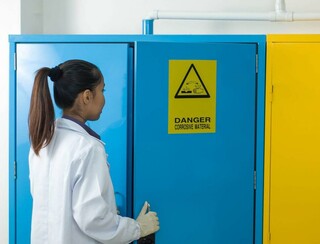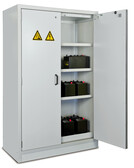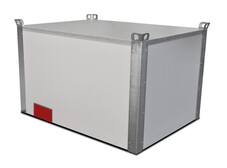Lithium-ion batteries are highly efficient energy carriers with a wide range of applications. With the increasing demand for this type of energy, energy storage has a particularly important role to play. This means that the demand for high-performance batteries will only increase. As a result of Hartmann Tresore's range of lithium-ion battery storage cabinets, more and more companies and institutions are turning to us for help in choosing the best solution. We are also seeing an increased interest in the subject of cabinets from thriving companies that are involved in the production of drones. The increasing manufacture of drones is justified given the ongoing conflict in Ukraine, but also for the security of our country.
Why is it important to store and charge batteries safely? We invite you to explore the topic further by reading this article.
Advantages of lithium batteries
Lithium ion batteries are popular for several reasons. These include among others:
• the high voltage level of the cell,
• there is no memory effect with secondary batteries (they can be recharged where there are no primary batteries),
• low self-discharge.
These properties make li-ion batteries increasingly popular in many areas, both in everyday life and industry. There are as yet no precise regulations indicating how batteries should be stored. Companies and institutions are operating a bit in the dark, trying to choose the best protection for their safe storage and charging during storage. Manufacturers, installers and users need to ensure the safety of themselves, their employees and the entire infrastructure. Technical defects or improper handling of batteries during storage, charging or operation can cause uncontrolled discharge of stored energy, leading to fires.
It is therefore extremely important to treat li-ion batteries as a hazardous material and to take special care during their manufacture, storage and transport.
Causes of lithium-ion battery fires
If a battery fire occurs, it is most often due to:
• overheating during charging,
• use of incorrect chargers or overcharging,
• deep discharge,
• mechanical damage,
• too high ambient temperature.
The list of factors is long and fires can occur for both internal and external reasons. So there is a need for proper storage and charging of lithium batteries, because the safety of both people and infrastructure should always be a priority. Awareness of hazards and risks in this regard is key.
Storage of lithium batteries and fire protection
Lithium ion batteries are hazardous products. Proper storage of batteries reduces the risk of a fire occurring and also spreading widely. For the proper protection, storage and containment of li-ion batteries there are:
• specially designed and tested fireproof cabinets,
• fireproof containers,
• fireproof rooms (solutions adapted to the storage of larger numbers of batteries).
Later in this article, we will discuss in detail the first of these, i.e. special cabinets for storing batteries, while as for the other two solutions – they will be discussed in the next article in the series on safe storage of li-ion batteries.
Cabinets for storing lithium-ion batteries available from HARTMANN TRESORE
When it comes to cabinets for hazardous and flammable materials, and in this case with lithium-ion batteries in mind, we offer products in a variety of sizes, but the most popular (due to their capacity and dimensions) are the double-door safety cabinets, type 90.
HTG 091-01 Li is a free-standing, 2-door cabinet for the safe storage of lithium-ion batteries. It is suitable for smoke-proof and fire-proof storage of lithium-ion batteries. It is made of A2 class non-combustible building material. It also has a ventilation system and cable feed-throughs at the top and bottom of the cabinet. Ventilation is an integrated system: smoke detectors and a fan.
Very importantly: the HTG 091-01 Li cabinet is fire-proof tested from the inside and outside, with a fire resistance rating of 90 minutes. There is a fire seal in the door (all around), which swells in the event of a fire outbreak.
The cabinet is protected against unauthorised access (cylinder lock). As standard, it is equipped with height-adjustable mesh shelves. The shelf load capacity is 75 kg.
As an option, battery storage cabinets may be equipped with a control unit with fire detection function (fault signalling by means of an optical signal and shutdown of the ventilation system), a fire extinguishing generator (operates independently of the current and is activated in the event of a fire and an unacceptable rise in temperature), a power strip or strips.
There is a plinth at the bottom of the enclosure, which allows it to be transported safely from site to site (using a forklift).
Application area for lithium-ion battery cabinets
Many everyday products are equipped with a rechargeable battery, and this means that large quantities of these batteries are stored in the companies that manufacture these items. Where are rechargeable batteries most commonly used?
• in companies that manufacture, sell and hire bicycles, cars and drones (electromobility),
• in companies dealing with small electrical appliances (electronic equipment, entertainment tools).
Note that storage in the disposal process is equally important.
Read also the related text: Cabinet for lithium-ion batteries – how to store this type of energy carrier safely
Lithium ion batteries – safety rules
The dangers associated with the risk of fire during the storage, conservation and charging of li-ion batteries are a fact of life. Taking care of li-ion batteries means following general safety rules such as:
• respecting the relevant manufacturer's specifications and product data sheets,
• prevention of external short circuits (short circuit protection),
• preventing internal short circuits (protection against mechanical damage),
• not exposing the battery directly and permanently to high temperatures or a heat source (e.g. direct sunlight),
• ensuring adequate distance from other combustible materials,
• immediate disposal of damaged or faulty lithium battery (proper disposal),
• short-term storage at a safe distance or in a fire-protected area.
Summary
There is growing awareness that lithium batteries are hazardous products if they are incorrectly handled or stored and that it is essential to protect them adequately, in the event of a fire. The best protection is provided by fire resistant cabinets.






